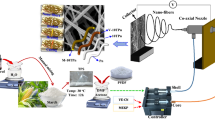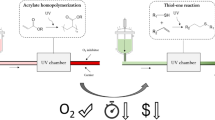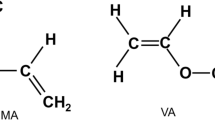Abstract
The isothermal cure of vinyl ester resins proceeds through several processes such as gelation, vitrification and behavior similar to autocatalysis. The cure kinetics of vinyl ester resins with poly(methyl methacrylate) or poly(vinyl acetate) as a low profile additive was analyzed by introducing a new kinetic model based on those processes. After the parameters in the model were determined through dynamic differential scanning calorimetry, the kinetic model was compared with isothermal DSC results. By using this model time–temperature–transformation (TTT) cure diagram was also plotted. The gelation time and vitrification time calculated from the kinetic model show good agreement with experimental values. Vinyl ester resin with a compatible low profile additive (i.e., PVAC) showed faster gelation but slower vitrification than the vinyl ester resin with an incompatible low profile additive (i.e., PMMA).
Similar content being viewed by others
Log in or create a free account to read this content
Gain free access to this article, as well as selected content from this journal and more on nature.com
or
References
R. E. Young, “Unsaturated Polyester Technology,” P. E. Bruins, Ed., Gordon and Breach, New York, N.Y., 1976, p 315.
S. H. Goonman, “Handbook of Thermoset Plastics,” Noyes Publications, New Jersey, 1986, p 76.
S. H. Rider and E. E. Hardy, “Polymerization and Polycondensation Processes,” N. A. J. Platzer, Ed., Adv. Chem. Ser. 34, The American Chemical Society, Washington, D. C., 1962.
C. D. Han and K. W. Lem, J. Appl. Polym. Sci., 28, 3155 (1983).
P. R. Paul and S. Newman, “Polymer Blends,” Vol. 2, Academic, New York, N.Y., 1978.
J. B. Enns and J. K. Gillham, J. Appl. Polym. Sci., 28, 2567 (1983).
M. R. Kamal and S. Sourour, Polym. Eng. Sci., 13, 59 (1973).
J. Mijovic, J. Appl. Polym. Sci., 31, 1177 (1986).
D. H. Kim and S. C. Kim, Polym. Bull., 18, 533 (1987).
P. J. Flory, “Principles of Polymer Chemistry,” Cornel University Press, New York, N.Y., 1953.
S. Lunka, J. Vladyka, and K. Dusek, Polymer, 19, 931 (1978).
A. T. Benedetto and L. E. Nielson, J. Macromol. Sci. Rev, Rev. Macromol. Chem., C3, 69 (1969).
K. D. Rusch, J. Macromol. Sci. Phys., B2(2), 179 (1968).
K. D. Rusch and R. H. Beck, J. Macromol. Sci. Phys., B(3), 365 (1965).
J. L. Kuester and J. M. Mize, “Optimization Techniques with FORTRAN,” McGraw-Hill, New York, N.Y., 1973.
J. K. Gillham, “Torsional Braid Analysis (TBA) of Polymers,” J. V. Dawkins, Ed., Applied Science, London, 1982, Chapter 5.
J. K. Gillham, ”Epoxy Resins and Composites III,” K. Dusek, Ed., Springer-Verlag, Berlin, Heidelberg, 1986.
G. L. Hagnauer, B. R. Laliberte, and D. A. Dunn, Preprint, Organic Coat Plastics, The American Chemical Society, A6, 646 (1982).
M. S. Hong and I. J. Chung, “The cure behavior of vinyl ester resin with low profile additives, Part II. Morphology and mechanical property,” submitted in Polym. J.
Author information
Authors and Affiliations
Rights and permissions
About this article
Cite this article
Hong, M., Chung, I. The Cure Behavior of Vinyl Ester Resin with Low Profile Additive I. Cure Kinetics and TTT Cure Diagram. Polym J 23, 747–755 (1991). https://doi.org/10.1295/polymj.23.747
Issue date:
DOI: https://doi.org/10.1295/polymj.23.747



